Abstract
Background: While efforts have been made to control meningococcal disease or carriage during mass gatherings (MGs), it is still a significant problem. This meta-analysis aims to assess the prevalence and predictors of meningitis carriage during MGs and travel. Methodology: PubMed, Scopus, Embase, and Cochrane were searched from their conception to January 2025. Cohort and cross-sectional studies assessing the prevalence of meningitis carriage and its serotype related to MGs and/or travel, and risk factors associated with its spread, were considered. The Newcastle–Ottawa scale was used for the quality assessment of studies. Results: Out of 1301 studies, 25 were considered for this meta-analysis. The largest geographic area involved was Saudi Arabia. A meta-analysis of 24 studies identified a pooled prevalence rate of meningococcal disease or carriage of 15.9% (95%CI: 4.45–27.4%) and the most frequent infecting organisms to be Serotype C (13.9%; 95%CI: −14.7 to 42.5; 4 studies) and A (11.5%; 95%CI: −2.13 to 25.2; 9 studies) among those at MGs or traveling. Age, gender, smoking history, and the vaccination status did not affect the infection risk. Conclusions: There is an increased prevalence of meningococcal disease and carriage, especially Serogroups A and C, associated with MGs and travel. New interventions and methodologies should be undertaken to control and prevent meningococcal disease or carriage transmission during such events.
1. Introduction
Meningococcal disease or carriage caused by Neisseria meningitidis (N. meningitidis) is a life-threatening condition that can lead to fatal complications such as meningitis, septicemia, and death [1]. It is a global health threat with varying risks by geographic region [2]. Meningococcal meningitis represented more than 400,000 cases globally and contributed to approximately 32,000 deaths in 2019 [3]. Its prevalence has been increasing with 422 cases of Serogroup Y reported in 2023 and 143 cases in the first quarter of 2024, indicating a significant upsurge, compared to the 81 cases reported during the same period in 2023 by the Centers for Disease Control and Prevention (CDC) in the United States of America [4].
Multiple factors, including mass gatherings (MGs), international travel, and migration, contribute to the spread of meningococcal infection. The World Health Organization (WHO) defines MGs as “an organized or unplanned event where the number of people attending is sufficient to strain the planning and response resources of the community, state or nation hosting the event” [5]. Similarly, the Center for Disease Control and Prevention (CDC) Yellow Book describes it as “large numbers of people (>1000) at a specific location, for a specific purpose” [6]. Practically speaking, an MG can be any assembly of people large enough to strain local resources [7], and we considered mass gathering (MG) events as the focus of interest. The increased movement of individuals, coupled with the close contact at large events, creates a unique environment conducive to the spread of meningococcal bacteria [8]. Recent studies and outbreaks have highlighted the significance of MGs, such as religious pilgrimages, festivals, and sporting events, as potential risk factors for meningococcal disease or carriage transmission [9]. Large crowds in confined spaces can facilitate the spread of respiratory droplets, which are the primary mode of transmission for N. meningitidis [10]. Reports of outbreaks during large public events, such as the Hajj pilgrimage, have brought global attention to the importance of vaccination and preventive measures when attending such events [8]. The risk is further compounded by travel to areas with a higher prevalence of meningococcal disease, particularly in the African meningitis belt [11].
Meningococcal disease or carriage remains a significant threat during MGs, particularly due to the increased risk of transmission in crowded settings. The Hajj pilgrimage is currently the only MG event where meningococcal vaccination is mandatory, with the Kingdom of Saudi Arabia requiring proof of quadrivalent (ACWY) vaccination for all pilgrims and workers [12]. Available meningococcal vaccines include conjugate (MenACWY), polysaccharide (MenACWY), and protein-based vaccines (MenB), each targeting different serogroups [13]. MenACWY vaccines protect against Serogroups A, C, W, and Y, while MenB vaccines are essential in regions where Serogroup B is prevalent [13]. Although other MGs like the Olympics or World Cup may issue health advisories, none currently enforce mandatory meningococcal vaccination policies similar to the Hajj pilgrimage [14].
Despite the growing recognition of these risks, the existing literature describing prevalence in relation to MGs and travel is scarce [14]. While several studies have investigated this issue [10,14,15], there is no comprehensive synthesis that quantifies the prevalence and risk factors linked to the spread of meningococcal disease or carriage during MGs or travel. Furthermore, while vaccination strategies have been implemented at several MGs, their effectiveness remains a subject of debate [16]. A systematic review and meta-analysis are necessary to consolidate findings from various studies, estimate the overall risk, and provide evidence-based recommendations for public health interventions.
This study aims to review the evidence on the prevalence and predictors of meningococcal disease or carriage and its serogroups during MGs and/or during travel. Additionally, we reviewed the evidence on the risk assessment from these studies.
2. Materials and Methods
This study was registered with PROSPERO (registration number CRD42025637006) [17]. We followed a Participant, Exposure, Comparator, Outcome, and Study (PECOS) design, as per the Cochrane Handbook of Systematic Reviews [18]. Findings were reported following the Preferred Reporting Items for Systematic Reviews and Meta-Analyses (PRISMA) statement 2020 [19].
2.1. Literature Search
A comprehensive search of PubMed/Medline (https://www.ncbi.nlm.nih.gov/pubmed/, accessed on 19 July 2025), Scopus (https://www.scopus.com/pages/home?display=basic#basic/, accessed on 19 July 2025), the Cochrane Library (http://www.cochranelibrary.com/, accessed on 19 July 2025), and Embase (https://www.embase.com/landing?status=yellow, accessed on 19 July 2025) from inception to 16 January 2025 was conducted. ProQuest Dissertations and Theses Global were also searched for any additional data. A bibliographic search of relevant previous review articles was performed to locate any relevant citations. The search strategy comprised all entry terms, Medical Subject Heading (MeSH) terms, and all keywords that belong to these two domains: (1) travel OR MG AND (2) meningococcus. A detailed search strategy is provided in Supplementary File S1.
2.2. Eligibility Criteria
Observational studies, such as cohort (retrospective, prospective, or ambispective) and cross-sectional studies, were considered. Only studies published in the English language that assessed the prevalence/incidence of meningococcal disease or carriage related to MG event, and/or associated with travel, were evaluated. Adult studies and studies of adults involving only a minor pediatric proportion (<10%) were included in this review to ensure no studies involving adults were excluded. However, studies with only a pediatric population were excluded.
Exposure was defined as factors that could occur during an MG such as, but not limited to, close contact (person-to-person transmission, airborne, or droplet pathogens), poor ventilation, duration of exposure, and shared surfaces. The exposure of interest should be associated with an MG event. However, the condition, such as outbreaks, region-specific disease, and vaccination, were excluded. Weakened immunity was examined as a risk factor in the subjects reviewed.
The primary outcome measured was the prevalence of meningococcal disease or carriage and its serogroup. Studies that either reported the overall incidence of meningococcal disease/carriage or its serogroup or both were also included. However, we did not consider studies which reported the surveillance of outbreaks, pandemics, or endemics that were not related to an MG. We considered both the carriage of meningococcus and the confirmed cases of meningococcal disease or carriage as per the authors’ reports. Secondary outcomes were risk factors associated with meningococcal disease among those who attend an MG, mortality associated with the incidence of meningococcal disease, quality of life, and economic burden in the study population. Reviews, case studies, protocols, guidelines, and individual case data and their follow-up were excluded.
2.3. Study Selection and Data Extraction
Publications were retrieved from the aforementioned databases as RIS/CVS files and exported to Rayyan software [Cambridge, MA, USA] (https://rayyan.ai/) [20] for duplicate removal and title and abstract screening. Remaining publications were exported to an Excel file and screened for study eligibility. A predefined data extraction grid was used for data extraction. Extracted information included characteristics of the studies (author, year, country, study design, location of the study, and place of data collection), type of exposure, type of gathering, subject characteristics (age, gender, number of infected people, the total number of people at risk, vaccination status, mortality), type of samples obtained for diagnostic testing, number of people tested, infection status, and serotype. Two independent reviewers performed the study selection and data extraction. Any disagreement during the study selection process and data extraction was resolved through discussion with a third author. Duplicates were removed by matching publication titles and authors.
2.4. Risk of Bias
Two review authors independently assessed the methodological quality of all the included studies using the Modified Newcastle Ottawa scale for cross-sectional studies [21], adapted from Herzog R et al. [22]. The selection, comparability, and outcome domain had a maximum of 5 scores, 3 scores, and 2 scores, respectively, totaling to a maximum possible score of 10. A score of 8–10 was considered high-quality, 6–8 moderate, and <6 low-quality. Disagreements were resolved by discussion between the investigators involved or by a third reviewer.
2.5. Strategy for Data Synthesis
The qualitative data from the individual studies were summarized in narrative form in tables, and quantitative data was pooled by meta-analysis. Review Manager Software (RevMan, version 5.4; The Cochrane Collaboration, London, UK) [23] and STATA Version 16 (StataCorp LLC, College Station, TX, USA) [24] were used for conducting the meta-analysis. The outcome was collected in terms of the number of infected cases and total number of samples in order to calculate the prevalence rate. The outcome was reported as a pooled estimate with 95% confidence interval (CI). The risk estimates were collected and reported as risk ratio (RR) with 95% CI. The statistical heterogeneity of data was assessed using the I2 statistic and Cochrane p value. A random-effects model was used to perform the meta-analysis [18]. Subgroup analyses were performed based on the serotype, type of travel, vaccination status, study design, study duration/time, and the test sample. The meta-regression was based on the study design, study duration/time, and the test sample to explore the sources of heterogeneity. A sensitivity analysis was performed by excluding the studies with the smallest sample size (<25% of the total sample) [25,26] to check the robustness of the findings. A funnel plot was generated for visual inspection of publication bias for outcomes which had a minimum of 10 studies in the analysis. The Egger’s test was used to statistically confirm any publication bias [18].
3. Results
3.1. Study Selection Process
The literature search yielded a total of 1301 articles. After the removal of duplicates (n = 556) and the exclusion of non-relevant articles (n = 649) during the initial screening, 96 relevant articles were identified for full-text screening. Of these, 71 were excluded, as described in Supplementary File S1. The 25 remaining publications [27,28,29,30,31,32,33,34,35,36,37,38,39,40,41,42,43,44,45,46,47,48,49,50,51] met the study criteria. The PRISMA flow diagram of the study selection process is provided in Figure 1. The list of excluded studies is provided in Supplementary File S2. The study by Fazio et al. [32] was excluded from the overall prevalence analysis as their focus was the serogroup data, and the number of patients at risk was not clearly stated. However, this study was considered for the meta-analysis of serogroups.
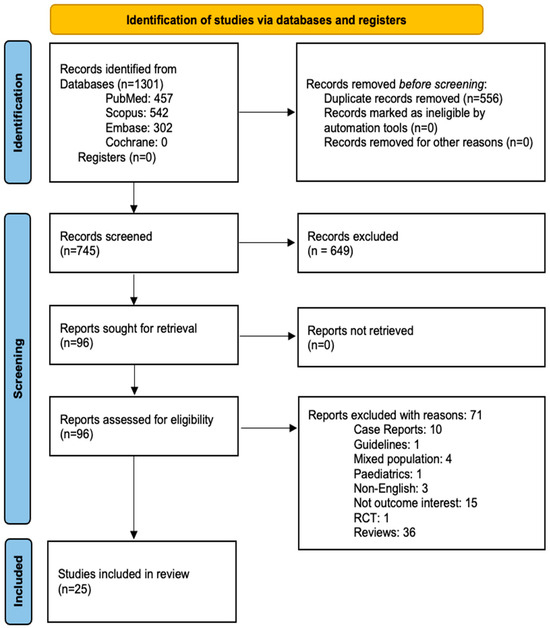
Figure 1.
The PRISMA flow diagram showing the study selection process.
3.2. Study Characteristics
A total of 25 studies were included in this systematic review, 9 of which were conducted in Saudi Arabia (n = 9; 36%). The included studies were prospective cohort (n = 14; 56%), retrospective cohort (n = 3; 12%), ambispective cohort (n = 1; 4%), and cross-sectional (n = 7; 28%) in nature. Gathering sites included airports (n = 8; 32%), home gatherings (n = 7; 28%), clinics/hospitals (n = 3; 12%), Muslim centers (n = 3; 12%), and a holy masjid (n = 1; 4%). The remaining three studies (12%) were collected from a public database. Most of the publications described subjects traveling and gathering for Hajj (n = 18; 72%), Umrah (n = 2; 8%), both Hajj and Umrah (n = 1; 4%), world travel (n = 3; 12%), or as refugee migration (n = 1; 4%). A detailed description of the characteristics is provided in Table 1.

Table 1.
Characteristics of included studies.
3.3. Characteristics of the Included Participants
The number of people in each publication ranged from 15 to 38,849, with a total of 61,509 (median: 373, IQR: 216.5–801.5). Men and women were present in similar numbers. There were 109 (0.18%) study subjects <18 years of age across the entire included study populations in the analyses. All subjects reported were vaccinated in 14 (56%) of the 25 studies. The biological material tested was obtained by a throat swab (10 publications; 40%), a nasopharyngeal swab (3 publications; 12%), a oropharyngeal swab (7 publications; 28%), cerebrospinal fluid (CSF) (2 publications, 8%), blood and CSF (1 publication, 4%), and other clinical samples (2 publications; 8%) (Table 2). A total of 67,140 biological samples were collected where participants were either tested once or multiple times. Of these samples, 4895 (7.29%) were observed to be positive for meningococcus. A detailed description of the subjects and samples is provided in Table 1 and Table 2.

Table 2.
Meningococcal testing data with type of sample tested, number of samples tested, number of samples infected with meningococcus, and serogroup.
3.4. Methodological Quality of Included Studies
All the studies were graded to be high-quality, as per the modified Newcastle Ottawa scale for cross-sectional studies. The studies scored from 8 to 10, with an average score of 9.04. The major concerns were the confounding factors, as many studies did not report the age, gender, geographic location, time and duration of exposure, behavioral factors, previous health conditions, or vaccination history. No studies performed an independent blind assessment. A detailed methodological quality assessment is provided in Table 3.

Table 3.
Quality assessment of included studies.
3.5. Primary Outcomes
3.5.1. Prevalence of Meningococcal Disease
A meta-analysis of 24 included studies demonstrated the pooled prevalence of meningococcal disease or carriage among those at risk as 15.9% (95%CI: 4.45–27.4%, I2: 100%), as shown in Figure 2. The subgroup analysis showed a higher prevalence of meningococcal disease or carriage among those at MGs (18.1%; 95%CI: 3.83–32.43; 19 studies) than among those that were traveling (4.41%; 95% CI: −5.92 to 14.7; 3 studies). Two publications reported people that traveled and attended MGs (9.99%; 95C% CI: 1.94 to 21.91). The publication heterogeneity was high for MGs (I2: 100%) and traveling (I2: 90%) separately; in contrast, the heterogeneity was 0% for studies where people traveled and attended MGs. The retrospective studies reported a higher prevalence of meningococcal disease/carriage than that of cross-sectional, ambispective, and prospective studies (53.75% vs. 14.04% vs. 6.32% vs. 3.57%). The studies conducted during 1990–2000 had a higher prevalence than that of studies conducted during 2000–2010 and 2010–2020 (29.58% vs. 14.49% vs. 11.43%). The results are presented in Supplementary Files S3–S5.
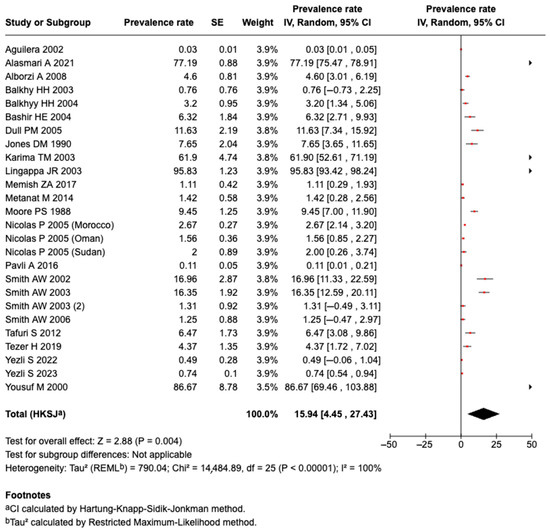
Figure 2.
The meta-analysis of the prevalence of meningococcal disease or carriage [27,28,29,30,31,33,34,35,36,37,38,39,40,41,42,43,44,45,46,47,48,49,50,51].
3.5.2. Exploration of Heterogeneity Through Subgroup Analysis
The subgroup analysis based on the travel history, study design, study duration/time, and test sample type indicated that those analyses in which the studies that reported both travel and mass gatherings (I2: 0%), being an ambispective study (I2: 0%), the use of blood and CSF (I2: 0%) or a bacterial isolate and/or culture sample (I2: 0%) might have contributed to the heterogeneity. However, the studies that included participants during a mass gathering or travel only; were cross-sectional, prospective, and retrospective studies; were conducted between 1990 and 2000, 2000 and 2010, and 2010 and 2020; and used throat samples, oropharyngeal swabs, nasopharyngeal swabs (all with I2: >90%), and CSF (I2: 83.8%) might have not influenced the heterogeneity (Supplementary Files S3–S6).
3.5.3. Results of Meta-Regression Analysis
The meta-regression indicated that the study duration/time, test sample, and study design did not significantly (p > 0.05) affect the heterogeneity in the analysis. The result of the meta-regression is provided in Table 4.

Table 4.
The results of the meta-regression.
3.5.4. Prevalence of Serogroup a Meningococcal Disease or Carriage
Nine studies reported Serogroup A meningococcal disease. A meta-analysis of the nine studies revealed that the pooled prevalence among those who traveled or attended an MG was 11.5% (95%CI: −2.13 to 25.15%, I2: 100%), as shown in Figure 3. There was a higher prevalence of Serogroup A meningococcal disease or carriage among those who attended an MG (13.1%; 95%CI: −2.43 to 28.65%, I2: 100%; n = 8 studies) than in those that traveled (0.59%; 95%CI: −0.57 to 1.75%; n = 1 study). However, there was no significant change in the heterogeneity, as shown in Supplementary File S7.
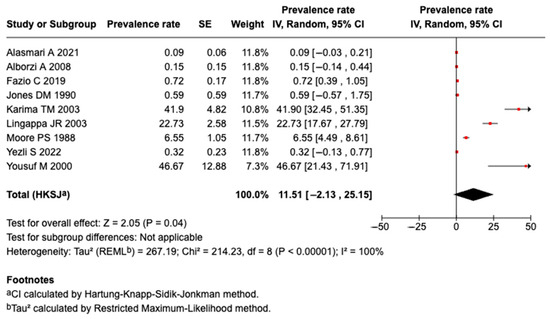
Figure 3.
The meta-analysis of the prevalence of Serogroup A [27,31,32,35,43,44,49,50,51].
3.5.5. Prevalence of Serogroup B Meningococcal Disease or Carriage
Twelve studies identified Serogroup B meningococcal disease. A meta-analysis of the 12 studies revealed that the pooled prevalence among those who traveled or attended an MG was 5.12% (95%CI: −3.67 to 13.91%, I2: 100%), as shown in Figure 4. There was a higher prevalence of Serogroup B meningococcal disease or carriage among those who attended an MG (5.36%; 95%CI: −4.28 to 15%, I2: 100%; n = 11 studies) than in those that traveled (2.33%; 95%CI: 0.31 to 4.35%; n = 1 study), as shown in Supplementary File S8.
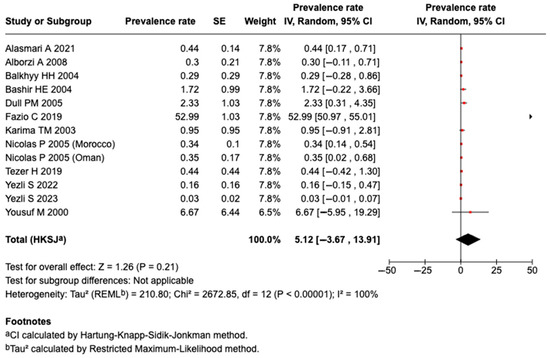
Figure 4.
The meta-analysis of the prevalence of Serogroup B [27,29,30,31,32,35,36,39,40,43,46,51].
3.5.6. Prevalence of Serogroup W135 Meningococcal Disease or Carriage
Twelve studies identified Serogroup W135 meningococcal disease. A meta-analysis of the 12 studies revealed that the pooled prevalence among those who traveled or attended an MG was 6.87% (95%CI: 1.35 to 12.39%, I2: 100%), as shown in Figure 5. There was a higher prevalence of Serogroup W135 meningococcal disease or carriage among those who attended an MG (7.51%; 95%CI: 1.05 to 13.96%, I2: 100%; n = 11 studies) than in those that traveled (1.99%; 95%CI: 0.05 to 3.93%; n = 1 study), as shown in Supplementary File S9.
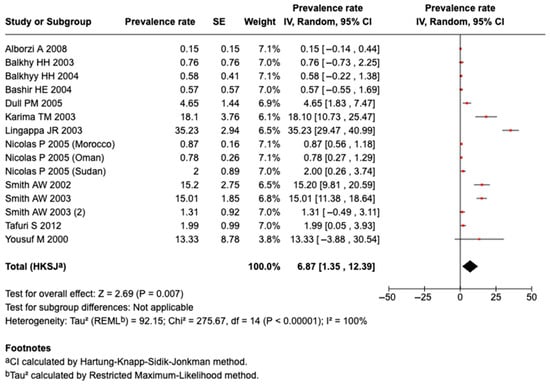
Figure 5.
The meta-analysis of the prevalence of Serogroup W135 [27,28,29,37,39,40,41,43,44,45,46,47,51].
3.5.7. Prevalence of Serogroup C Meningococcal Disease or Carriage
Four studies identified Serogroup C meningococcal disease or carriage. A meta-analysis of the four studies revealed that the pooled prevalence among those who traveled or attended an MG was 13.9% (95%CI: −14.73 to 42.49%, I2: 100%), as shown in Figure 6.
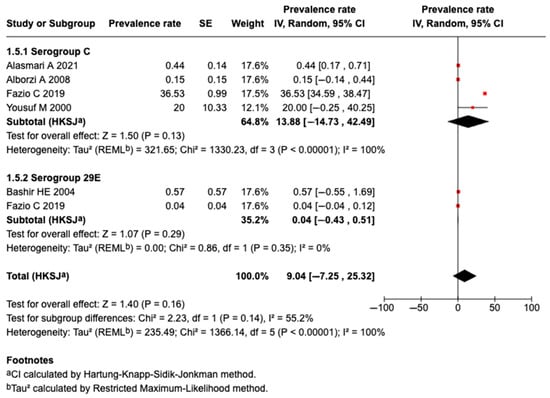
Figure 6.
The meta-analysis of the prevalence of Serogroups C and 29E [27,31,32,40,51].
3.5.8. Prevalence of Serogroup 29E Meningococcal Disease or Carriage
Two studies identified Serogroup 29E meningococcal disease or carriage. A meta-analysis of the two studies revealed that the pooled prevalence among those who traveled or attended an MG was 0.04% (95%CI: −7.25 to 25.32%, I2: 0%), as shown in Figure 6.
3.5.9. Prevalence of Serogroup W Meningococcal Disease or Carriage
Three studies identified Serogroup W meningococcal disease or carriage. A meta-analysis of three studies revealed that the pooled prevalence among those who traveled or attended an MG was 3.40% (95%CI: −6.74 to 13.54%, I2: 99%), as shown in Figure 7.
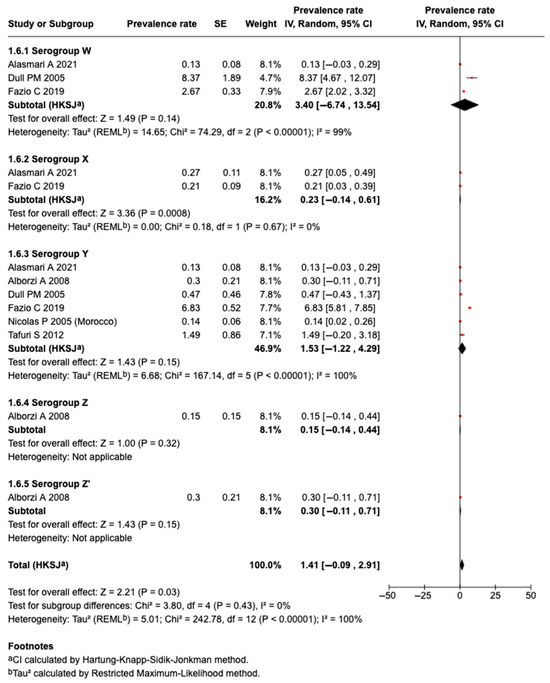
Figure 7.
The meta-analysis of the prevalence of Serogroups W, X, Y, and Z [31,32,37,39,46,51].
3.5.10. Prevalence of Serogroup X Meningococcal Disease or Carriage
Two studies identified Serogroup X meningococcal disease or carriage. A meta-analysis of the two studies revealed that the pooled prevalence among those who traveled or attended an MG was 0.23% (95%CI: −0.14 to 0.61%, I2: 0%), as shown in Figure 7.
3.5.11. Prevalence of Serogroup Y Meningococcal Disease or Carriage
Six studies identified Serogroup Y meningococcal disease or carriage. A meta-analysis of six studies revealed that the pooled prevalence among those who traveled or attended an MG was 1.53% (95%CI: −1.22 to 4.29%, I2: 100%), as shown in Figure 7.
3.5.12. Prevalence of Serogroup Z Meningococcal Disease or Carriage
One study identified Serogroups Z and Z’ meningococcal disease or carriage. The prevalence rate of Serogroup Z was 0.15% (−0.14 to 0.44) and Serogroup Z’ was 0.30%, among subjects who attended an MG, as shown in Figure 7.
3.5.13. Prevalence of Non-Groupable Meningococcal Disease or Carriage
Eleven studies identified non-groupable meningococcal disease or carriage. A meta-analysis of the 11 studies revealed that the pooled prevalence among those who traveled or attended an MG was 2.19% (95%CI: 0.91 to 3.47%, I2: 97%), as shown in Figure 8. There was a higher prevalence of non-groupable meningococcal disease or carriage among studies containing subjects who both traveled and attended an MG together (4.64%; 95%CI: −20.92 to 30.20%; I2: 79%; n = 2 studies) than in the nine studies reporting MGs alone (1.71%; 95%CI: 0.51 to 2.92%, I2: 96%; n = 9 studies). However, there was no significant change in the heterogeneity, as shown in Supplementary File S10.
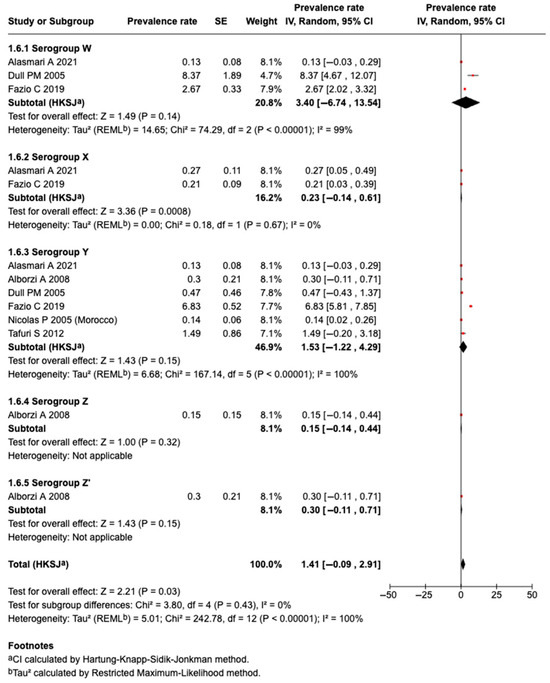
Figure 8.
The meta-analysis of the prevalence of non-groupable and auto-agglutinable meningococcal disease or carriage [31,32,37,39,46,51].
3.5.14. Prevalence of Auto-Agglutinable Meningococcal Disease or Carriage
Two studies identified auto-agglutinable meningococcal disease or carriage. A meta-analysis of the two studies revealed that the pooled prevalence among those who traveled or attended an MG was 1.59% (95%CI: −13.14 to 16.31%, I2: 67%), as shown in Figure 8.
3.5.15. Effect of Vaccination on Prevalence of Meningococcal Diseases or Carriage
The prevalence of meningococcal disease or carriage among fully vaccinated people was 15.97% (95%CI: −0.96 to 32.90%; I2: 100% n = 15 studies) and was 16.0% (95%CI: −2.06 to 33.99%; I2: 100%; n = 9 studies) among those not vaccinated. However, there was no significant change in heterogeneity, as shown in Figure 9.
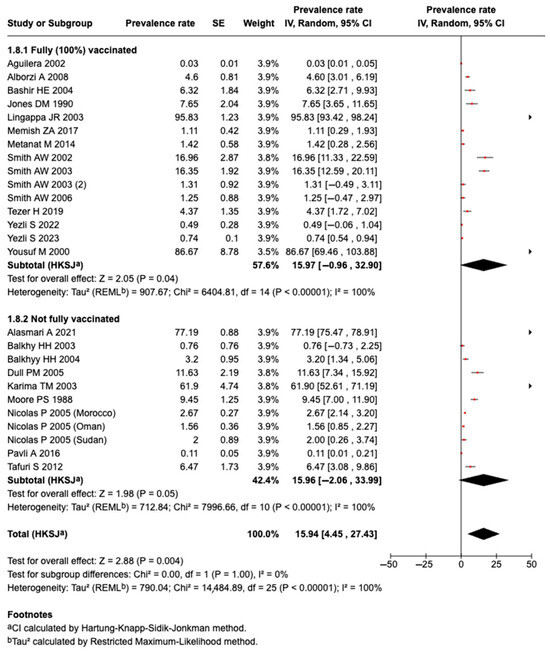
Figure 9.
The effect of vaccination on the prevalence of meningococcal disease or carriage [27,28,29,30,31,33,34,35,36,37,38,39,40,41,42,43,44,45,46,47,48,49,50,51].
3.5.16. Risk Factors Associated with the Prevalence of Meningococcal Disease or Carriage
Age, gender, smoking, and vaccination histories were evaluated as risk factors for meningococcal disease. None of them was identified as a risk factor (Age: 35–44 years of age [RR: 0.64; 95%CI: 0.16–2.56; I2: 0%; n = 2 studies; p = 0.692], 45–54 years of age [RR: 1.06; 95%CI: 0.37–3.10; I2: 0%; n = 2 studies; p = 0.661]; 55–64 years of age [RR: 0.98; 95%CI: 0.32–2.98; I2: 0%; n = 2 studies; p = 0.979], above 65 years of age [RR: 1.10; 95%CI: 0.24–5.11; n = 1 studies]; male gender [RR: 0.83; 95%CI: 0.43–1.58; I2: 34.99%; n = 3 studies; p = 0.215]; smoking history [RR: 1.10; 95%CI: 0.37–3.29; I2: 0%; n = 2 studies; p = 0.568]; and non-vaccinated status [RR: 1.48; 95%CI: 0.50–4.38; I2: 38.5%; n = 2 studies, p = 0.202]), as presented in Supplementary Files S9–S12.
3.6. Secondary Outcomes
3.6.1. Mortality
Yousuf M et al. reported a mortality rate of 33%, with the poorest outcome in patients with a Serogroup W135 meningococcus infection [27]. Lingappa et al. reported a case fatality rate of 28% among all infected subjects (29% for Serogroup W-135 and 27% for Serogroup A) [44]. Jones DM et al. reported five deaths (13%) among 39 subjects diagnosed with Serogroup A infections [50]. Auguilera JF et al. reported the overall case fatality rate of European patients infected with Serogroup W-135 to be 15.6%, with a higher rate among subjects from the United Kingdom, 19%, and France, 16.7%, and a lower rate from other countries, 8.3% [48].
3.6.2. Other Outcomes
No studies reported outcomes related to the quality of life or economic burden.
3.7. Publication Bias
The visual inspection of the funnel plots indicated a possible publication bias. This was statistically confirmed with Egger’s test (p < 0.05) for the outcome prevalence of meningococcal disease or carriage and its serogroup. The results are presented in Supplementary Files S13–S16.
3.8. Sensitivity Analysis
The sensitivity analysis was repeated after removing the two smallest studies. The prevalence of meningococcal disease or carriage in this subgroup was 13.9% (95%CI: 3.00–24.75%; I2: 100%; 22 studies). The exclusion of these two studies did not influence the study heterogeneity (Figure 2). The results of the sensitivity analysis are provided in Supplementary File S17.
4. Discussion
This systematic review and meta-analysis aimed to assess the prevalence and risk factors associated with meningococcal disease or carriage at MGs and during international travel. The meta-analysis of prevalence data was important because it supplied information about the current landscape of the disease and its associated contributors [25,26]. The findings from the reviewed studies underscore the elevated prevalence of meningococcal disease or carriage in people attending MGs and during travel. The risk of communicable disease transmission is high during MGs as there is close contact with multiple people from different geographical locations who can be infected, different immunity patterns, and different serotypes [52]. Shared accommodations, unhygienic practices, poor gathering etiquette, inadequate sanitation, a lack of cleanliness, smoking, and the overall health status of the participants have been described as risk factors for spread [53].
The Hajj and Umrah pilgrimages are among the largest MGs globally and have been linked to an increased risk of infectious diseases, including meningococcal infection [54]. The densely packed environment, the long duration of close contact, and international travel facilitate the transmission of Neisseria meningitidis during these events [55]. Multiple groups, including the World Health Organization, have recommended the use of pre-travel vaccination against meningococcal disease or carriage in order to prevent outbreaks during pilgrimages [56].
This analysis identified an overall pooled prevalence of meningococcal disease or carriage of 15.9%, with a higher proportion occurring among those attending MGs (18.1%). Serogroup C was most common (13.9%), followed by Serogroup A (11.5%). These findings are consistent with global surveillance data [57]. The higher prevalence of Serogroup C at mass gatherings aligns with previous reports linking this serogroup to large-scale outbreaks [58]. These results emphasize the importance of targeted vaccination strategies, particularly for Serogroups A and C, prior to attending MGs [59,60]. Meningococcal vaccination can reduce the risk of mortality and serious long-term sequelae [61], and efforts should be made to address the inadequate vaccinations [62].
In addition to the predominance of Serogroups A and C, the potential for Serogroup B (MenB) outbreaks at mass gatherings (MGs) such as the Hajj has been highlighted in the literature. Although historically less associated with large-scale outbreaks during Hajj, MenB remains a concern due to its unpredictable epidemiology and the lack of cross-protection from MenACWY vaccines. The literature has warned of the possibility of MenB emergence during Hajj, particularly as countries with rising MenB incidences contribute to the pilgrim population [63]. The availability of protein-based MenB vaccines (e.g., Bexsero and Trumenba) now offers targeted protection, especially in settings like universities and MGs where MenB transmission has been documented [64]. While these vaccines are not universally required for Hajj, their inclusion in pre-travel immunization strategies could mitigate the risk of MenB-related outbreaks.
The introduction of the MenAfriVac, a conjugate vaccine targeting Serogroup A, has significantly reduced the MenA incidence across the African meningitis belt, a region from which many Hajj pilgrims originate [65]. This success, combined with Saudi Arabia’s mandatory MenACWY vaccination policy for all Hajj pilgrims, has contributed to a marked decline in Serogroup A, C, W, and Y outbreaks during the pilgrimage [66]. The recent development of pentavalent MenABCWY vaccines, which offer a broader protection in a single formulation, presents a promising tool for future MG preparedness [67,68]. As MGs continue to grow in scale and diversity, integrating such vaccines into routine and event-specific immunization programs could enhance global health security and reduce the burden of meningococcal disease or carriage [14,69].
The prevalence of meningococcal disease or carriage during MGs, such as Hajj, varies by region. Some participants originate from countries with limited access to vaccines or do not adhere to vaccination recommendations [70]. MGs in countries with high endemicity, such as sub-Saharan Africa, are associated with a marked increase in disease risk [71]. Additionally, some of the analyses had a high prevalence rate of meningococcal infections. This might be due to the inclusion of surveillance studies which may not entirely represent the actual number of cases. This might have affected the overall outcome results.
Meningococcal vaccines, both conjugate and protein-based, have demonstrated a strong effectiveness in preventing invasive meningococcal disease, yet the longevity of the protection, particularly into adulthood, remains less clearly defined, especially when the primary immunization occurs in early adolescence [72]. National vaccination programs vary widely in terms of age groups targeted, included serogroups, and the overall uptake, creating gaps in protection that may leave some adults vulnerable during mass gatherings [73]. Given the heightened risk of meningococcal disease or carriage transmission in crowded settings, such as the Hajj pilgrimage and international festivals, tailored vaccination strategies including boosters and broader vaccine coverage should be considered for adults and older adults planning to attend these high-risk events [74].
Our evaluation of age, gender, smoking, and the vaccination status as risk factors for the spread of meningococcal disease or carriage did not identify any significantly associated risk. This finding is in contrast with previous research [75], which sometimes identified a younger age and a lack of vaccination as important determinants of risk. For example, younger individuals, particularly those under 25 years of age, have been found to be at a higher risk for meningococcal disease or carriage due to behaviors that increase close contact [76]. This finding needs to be interpreted with caution, as these results were obtained from prevalence studies which may not be an accurate design to ascertain a causal risk association. The lack of associated risk factors in our study may be due to the varied nature caused by including the geographical location of the events and differences in the race, country of origin, ethnicity, and hereditary and immune makeup of travelers. The high degree of the heterogeneity of these factors and the lack of detailed descriptions of all groups made the subgroup analysis difficult. Further study is needed to evaluate the role and interplay of these factors. There was little difference in the prevalence of meningococcal disease or carriage in fully vaccinated and partially vaccinated individuals we reviewed. These findings question the effectiveness of vaccination programs in preventing meningococcal disease or carriage during the MGs examined and travel. This finding may be explained by the inconsistent vaccine coverage among MG attendees, travel before an immune reaction has time to develop, or by the loss of vaccine efficacy over time, as the time from the last vaccination was not available for review [77]. Previous studies have shown that despite high vaccination rates, outbreaks still occurred due to factors such as an inadequate vaccine administration and the emergence of new serogroups [78,79]. Mortality was not assessed by many studies, which might be due to the cross-sectional nature of the studies. Further investigations are needed with long-term follow-up to better characterize our secondary outcome.
There are several limitations to this study. The evaluation of only English-language publications might have excluded some studies, especially regional-based studies. A comprehensive search strategy that used multiple databases was performed to minimize this risk. The quality of life and economic burden associated with meningococcal disease or carriage during MGs or travel were factors of interest to us; however, none of the studies reported this. It is important to note that the heterogeneity in this analysis was considerably high. However, this is expected due to the observational nature of the studies included and mixed populations. However, we conducted the subgroup analysis and sensitivity analysis to explore this high heterogeneity. The small amount of available data and the observational nature of studies (surveillance studies) used in the subgroup analyses and risk estimates might have affected our ability to detect a significant association. The detailed subgroup data was not available, as described above. Finally, this review is limited to meningococcal disease or carriage, IMD cases, and carriages at MG events that were sufficiently documented in the scientific literature, potentially underestimating the true burden. Events such as music and sporting festivals may be underrepresented, as illustrated by the briefly mentioned MenB case at the 2017 Boardmasters Festival in the UK [80].
The detailed vaccination data was not available in many studies. Other factors, such as the density of the crowded conditions, the duration of the exposure, the type of exposure during the MG, personal habits, and environmental factors should be explored in future studies. These findings suggest that further research is needed to identify other contributing factors and improve preventive strategies for meningococcal disease or carriage at mass-gatherings and during travel.
5. Conclusions
This study highlights the increased prevalence of meningococcal disease or carriage, especially Serogroups A and C, associated with MGs and travel. Age, gender, smoking, and vaccination status were not identified as risk factors for meningococcal disease or carriage in this study. The subgroup analyses and meta-regression did not rule out any factors that affect the heterogeneity. These findings underscore the need for the continued study of this problem and strategies to mitigate the risk of outbreaks during large-scale events and travel.
Supplementary Materials
The following supporting information can be downloaded at https://www.mdpi.com/article/10.3390/tropicalmed10080207/s1, Supplementary File S1: (A–D) Detailed search strategy; Supplementary File S2: List of excluded studies; Supplementary File S3: Prevalence of meningococcal disease or carriage based on travel history; Supplementary File S4: Prevalence of meningococcal disease or carriage based on study design; Supplementary File S5: Prevalence of meningococcal disease or carriage based on study duration/time; Supplementary File S6: Prevalence of meningococcal disease or carriage based on test sample; Supplementary File S7: Prevalence of serogroup A meningococcal disease or carriage based on travel history; Supplementary File S8: Prevalence of serogroup B meningococcal disease or carriage based on travel history; Supplementary File S9: Prevalence of serogroup W135 meningococcal disease or carriage based on travel history; Supplementary File S10: Prevalence of Non-groupable serogroup meningococcal disease or carriage based on travel history; Supplementary File S11: Risk of meningococcal disease or carriage based on age in years; Supplementary File S12: Risk of meningococcal disease or carriage for male gender; Supplementary File S13: Risk of meningococcal disease or carriage among those with any smoking history; Supplementary File S14: Risk of meningococcal disease or carriage among those with no vaccination; Supplementary File S15: Funnel plot for meningococcal disease or carriage; Supplementary File S16: Funnel plot for group B meningococcal disease or carriage; Supplementary File S17: Funnel plot for group W135 meningococcal disease or carriage; Supplementary File S18: Funnel plot for group W135 meningococcal disease or carriage; Supplementary File S19: Sensitivity analysis.
Author Contributions
Conceptualization, M.S., H.A., J.M., A.T., R.M.A., H.M.A. (Hani M. Almoallim), I.A.A., M.S.O., A.M.A.A., A.S.H.A., H.M.A. (Heba M. Adly), A.A.K., F.A.A. and M.A.G. Data collection: M.S., H.A., J.M., A.T., R.M.A., H.M.A. (Hani M. Almoallim), I.A.A., M.S.O., A.M.A.A., A.S.H.A., H.M.A. (Heba M. Adly), A.A.K., F.A.A. and M.A.G. Formal analysis: M.S., H.A., J.M., A.T., R.M.A., H.M.A. (Hani M. Almoallim), I.A.A., M.S.O., A.M.A.A., A.S.H.A., H.M.A. (Heba M. Adly), A.A.K., F.A.A. and M.A.G. Methodology: M.S. and H.M.A. (Hani M. Almoallim). Project administration: H.M.A. (Hani M. Almoallim). Software: H.A., J.M. and M.S.O. Supervision: M.S. and H.M.A. (Hani M. Almoallim). Writing—original draft preparation: M.S., H.A., J.M., A.T., R.M.A., H.M.A. (Hani M. Almoallim), I.A.A., M.S.O., A.M.A.A., A.S.H.A., H.M.A. (Heba M. Adly), A.A.K., F.A.A. and M.A.G. Writing—review and editing: M.S., H.A., J.M., A.T., R.M.A., H.M.A. (Hani M. Almoallim), I.A.A., M.S.O., A.M.A.A., A.S.H.A., H.M.A. (Heba M. Adly), A.A.K., F.A.A. and M.A.G. All authors have read and agreed to the published version of the manuscript.
Funding
This research received no external funding.
Institutional Review Board Statement
Not applicable.
Informed Consent Statement
Not applicable.
Data Availability Statement
All the data and materials related to this article is available in this manuscript and Supplementary Files. Any additional data can be made available from the corresponding author on appropriate request.
Conflicts of Interest
The authors declare no conflicts of interest.
Abbreviations
The following abbreviations are used in this manuscript:
| CDC | Centers for Disease Control and Prevention |
| PROSPERO | International Prospective Register of Systematic Reviews |
| CRD | Part of the PROSPERO Registration Number |
| PECOS | Participant, Exposure, Comparator, Outcome, and Study |
| MeSH | Medical Subject Heading |
| IQR | Interquartile Range |
| CSF | Cerebrospinal Fluid |
| RR | Risk Ratio |
| RevMan | Review Manager Software |
| MGs | Mass Gatherings |
References
- Pardo de Santayana, C.; Htar, M.T.T.; Findlow, J.; Balmer, P. Epidemiology of invasive meningococcal disease worldwide from 2010–2019: A literature review. Epidemiol. Infect. 2023, 151, e57. [Google Scholar] [CrossRef] [PubMed]
- Stephens, D.S. Global Control of Meningococcal Disease. N. Engl. J. Med. 2023, 388, 2003–2005. [Google Scholar] [CrossRef] [PubMed]
- Shen, S.; Findlow, J.; Peyrani, P. Global Epidemiology of Meningococcal Disease-Causing Serogroups Before and After the COVID-19 Pandemic: A Narrative Review. Infect. Dis. Ther. 2024, 13, 2489–2507. [Google Scholar] [CrossRef] [PubMed]
- CDC. Increase in Invasive Serogroup Y Meningococcal Disease in the United States; CDC Health Alert Network; Centre for Disease Control: Atlanta, GA, USA, 2024.
- World Health Organization. Public Health for Mass Gatherings: Key Considerations; WHO: Geneva, Switzerland, 2015. [Google Scholar]
- Halsey, E. CDC Yellow Book 2026: Health Information for International Travel; Oxford University Press: Oxford, UK, 2025. [Google Scholar]
- Burki, T.K. Mass gatherings and respiratory disease. Lancet Respir. Med. 2013, 1, 598. [Google Scholar] [CrossRef] [PubMed]
- Dubey, A.P.; Hazarika, R.D.; Abitbol, V.; Kolhapure, S.; Agrawal, S. Mass gatherings: A review of the scope for meningococcal vaccination in the Indian context. Hum. Vaccines Immunother. 2021, 17, 2216–2224. [Google Scholar] [CrossRef] [PubMed]
- Memish, Z.A.; Steffen, R.; White, P.; Dar, O.; Azhar, E.I.; Sharma, A.; Zumla, A. Mass gatherings medicine: Public health issues arising from mass gathering religious and sporting events. Lancet 2019, 393, 2073–2084. [Google Scholar] [CrossRef] [PubMed]
- Rouphael, N.G.; Stephens, D.S. Neisseria meningitidis: Biology, microbiology, and epidemiology. Methods Mol. Biol. 2012, 799, 1–20. [Google Scholar] [PubMed]
- Alshamrani, M.; Farahat, F.; Alzunitan, M.; Hasan, M.A.; Alsherbini, N.; Albarrak, A.; Al Johani, S.M.; Al-Tawfiq, J.A.; Zumla, A.; Memish, Z.A. Hajj vaccination strategies: Preparedness for risk mitigation. J. Infect. Public Health 2024, 17, 102547. [Google Scholar] [CrossRef] [PubMed]
- Al-Tawfiq, J.A.; Memish, Z.A. The Hajj 2019 Vaccine Requirements and Possible New Challenges. J. Epidemiol. Glob. Health 2019, 9, 147–152. [Google Scholar] [CrossRef] [PubMed]
- Al-Tawfiq, J.A.; Gautret, P.; Memish, Z.A. Expected immunizations and health protection for Hajj and Umrah 2018—An overview. Travel. Med. Infect. Dis. 2017, 19, 2–7. [Google Scholar] [CrossRef] [PubMed]
- Yezli, S. The threat of meningococcal disease during the Hajj and Umrah mass gatherings: A comprehensive review. Travel Med. Infect. Dis. 2018, 24, 51–58. [Google Scholar] [CrossRef] [PubMed]
- Salmon-Rousseau, A.; Piednoir, E.; Cattoir, V.; de La Blanchardière, A. Hajj-associated infections. Med. Mal. Infect. 2016, 46, 346–354. [Google Scholar] [CrossRef] [PubMed]
- Vuocolo, S.; Balmer, P.; Gruber, W.C.; Jansen, K.U.; Anderson, A.S.; Perez, J.L.; York, L.J. Vaccination strategies for the prevention of meningococcal disease. Hum. Vaccines Immunother. 2018, 14, 1203–1215. [Google Scholar] [CrossRef] [PubMed]
- Almoallim, H.A.H.; Samannodi, M. Meningococcal Disease Burden and Transmission Related to Mass Gatherings and Travel: A Systematic Review and Meta-Analysis; York University: North York, ON, Canada, 2025. [Google Scholar]
- Higgins, J.P.; Thomas, J.; Chandler, J.; Cumpston, M.; Li, T.; Page, M.J.; Welch, V.A. Cochrane Handbook for Systematic Reviews of Interventions; John Wiley & Sons: Chichester, UK, 2019. [Google Scholar]
- Page, M.J.; Moher, D.; Bossuyt, P.M.; Boutron, I.; Hoffmann, T.C.; Mulrow, C.D.; Shamseer, L.; Tetzlaff, J.M.; Akl, E.A.; Brennan, S.E.; et al. PRISMA 2020 explanation and elaboration: Updated guidance and exemplars for reporting systematic reviews. BMJ 2021, 372, n160. [Google Scholar] [CrossRef] [PubMed]
- Ouzzani, M.; Hammady, H.; Fedorowicz, Z.; Elmagarmid, A. Rayyan—A web and mobile app for systematic reviews. Syst. Rev. 2016, 5, 210. [Google Scholar] [CrossRef] [PubMed]
- Blanchard, L.R.S.; Law, C. The Effectiveness, Cost-Effectiveness and Policy Processes of Regulatory, Voluntary and Partnership Policies to Improve Food Environments: An Evidence Synthesis; Appendix 4, Modifications to the Newcastle–Ottawa Scale for cross-sectional studies; National Institute for Health and Care Research: Southampton, UK, 2024. [Google Scholar]
- Herzog, R.; Álvarez-Pasquin, M.J.; Díaz, C.; Del Barrio, J.L.; Estrada, J.M.; Gil, Á. Are healthcare workers’ intentions to vaccinate related to their knowledge, beliefs and attitudes? A systematic review. BMC Public Health 2013, 13, 154. [Google Scholar] [CrossRef] [PubMed]
- RevMan. Review Manager (RevMan) [Computer Program]; Version 5.4; The Cochrane Collaboration: Oxford, UK, 2020. [Google Scholar]
- StataCorp. Stata Statistical Software Release, 16th ed.; StataCorp LLC: College Station, TX, USA, 2019. [Google Scholar]
- Rashid, M.; Chhabra, M.; Kashyap, A.; Undela, K.; Gudi, S.K. Prevalence and Predictors of Self-Medication Practices in India: A Systematic Literature Review and Meta-Analysis. Curr. Clin. Pharmacol. 2020, 15, 90–101. [Google Scholar] [CrossRef] [PubMed]
- Suhita, R.; Begum, I.; Rashid, M.; Chandran, V.P.; Shastri, S.A.; Kantamneni, R.; Rajan, A.K.; Thunga, G. Systematic review and meta-analysis of global prevalence of neurotoxic and hemotoxic snakebite envenomation. East Mediterr. Health J. 2022, 28, 909–916. [Google Scholar] [CrossRef] [PubMed]
- Yousuf, M.; Nadeem, A. Meningococcal infection among pilgrims visiting Madinah Al-Munawarah despite prior A-C vaccination. J. Pak. Med. Assoc. 2000, 50, 184–186. [Google Scholar] [PubMed]
- Balkhy, H.H.; Memish, Z.A.; Osoba, A.O. Meningococcal carriage among local inhabitants during the pilgrimage 2000–2001. Int. J. Antimicrob. Agents 2003, 21, 107–111. [Google Scholar] [CrossRef] [PubMed]
- Balkhy, H.H.; Memish, Z.A.; Almuneef, M.A.; Osoba, A.O. Neisseria meningitidis W-135 carriage during the Hajj season 2003. Scand. J. Infect. Dis. 2004, 36, 264–268. [Google Scholar] [CrossRef] [PubMed]
- Yezli, S.; Yassin, Y.; Mushi, A.; Alabdullatif, L.; Alburayh, M.; Alotaibi, B.M.; Khan, A.; Walsh, L.; Lekshmi, A.; Walker, A.; et al. Carriage of Neisseria meningitidis among travelers attending the Hajj pilgrimage, circulating serogroups, sequence types and antimicrobial susceptibility: A multinational longitudinal cohort study. Travel Med. Infect. Dis. 2023, 53, 102581. [Google Scholar] [CrossRef] [PubMed]
- Alasmari, A.; Houghton, J.; Greenwood, B.; Heymann, D.; Edwards, P.; Larson, H.; Assiri, A.; Ben-Rached, F.; Pain, A.; Behrens, R.; et al. Meningococcal carriage among Hajj pilgrims, risk factors for carriage and records of vaccination: A study of pilgrims to Mecca. Trop. Med. Int. Health 2021, 26, 453–461. [Google Scholar] [CrossRef] [PubMed]
- Fazio, C.; Neri, A.; Vacca, P.; Ciammaruconi, A.; Arghittu, M.; Barbui, A.M.; Vocale, C.; Bernaschi, P.; Isola, P.; Galanti, I.A.; et al. Cocirculation of Hajj and non-Hajj strains among serogroup W meningococci in Italy, 2000 to 2016. Eurosurveillance 2019, 24, 4. [Google Scholar] [CrossRef] [PubMed]
- Pavli, A.; Katerelos, P.; Smeti, P.; Maltezou, H.C. Meningococcal vaccination for international travellers from Greece visiting developing countries. Travel Med. Infect. Dis. 2016, 14, 261–266. [Google Scholar] [CrossRef] [PubMed]
- Metanat, M.; Sharifi-Mood, B.; Sanei-Moghaddam, S.; Rad, N.S. Pharyngeal carriage rate of Neisseria meningitidis before and after the Hajj pilgrimage, in Zahedan (southeastern Iran), 2012. Turk. J. Med. Sci. 2015, 45, 1317–1320. [Google Scholar] [CrossRef] [PubMed]
- Yezli, S.; Yassin, Y.; Mushi, A.; Bukhari, M.; Banasser, T.; Khan, A. Carriage of Neisseria meningitidis Among Umrah Pilgrims: Circulating Serogroups and Antibiotic Resistance. Infect. Drug Resist. 2022, 15, 4685–4696. [Google Scholar] [CrossRef] [PubMed]
- Tezer, H.; Gülhan, B.; Simge Gişi, A.; Nar Ötgün, S.; Kanık-Yüksek, S.; Özkaya-Parlakay, A.; Kılıç, S.; Şahin, N.Ü.; Şimşek, A.Ç.; Kara, A. The impact of meningococcal conjugate vaccine (MenACWY-TT) on meningococcal carriage in Hajj Pilgrims returning to Turkey. Hum. Vaccines Immunother. 2020, 16, 1268–1271. [Google Scholar] [CrossRef] [PubMed]
- Tafuri, S.; Prato, R.; Martinelli, D.; Germinario, C. Prevalence of carriers of Neisseria meningitidis among migrants: Is migration changing the pattern of circulating meningococci? J. Travel Med. 2012, 19, 311–313. [Google Scholar] [CrossRef] [PubMed]
- Memish, Z.A.; Al-Tawfiq, J.A.; Almasri, M.; Azhar, E.I.; Yasir, M.; Al-Saeed, M.S.; Ben Helaby, H.; Borrow, R.; Turkistani, A.; Assiri, A. Neisseria meningitidis nasopharyngeal carriage during the Hajj: A cohort study evaluating the need for ciprofloxacin prophylaxis. Vaccine 2017, 35, 2473–2478. [Google Scholar] [CrossRef] [PubMed]
- Dull, P.M.; Abdelwahab, J.; Sacchi, C.T.; Becker, M.; Noble, C.A.; Barnett, G.A.; Kaiser, R.M.; Mayer, L.W.; Whitney, A.M.; Schmink, S.; et al. Neisseria meningitidis serogroup W-135 carriage among US travelers to the 2001 Hajj. J. Infect. Dis. 2005, 191, 33–39. [Google Scholar] [CrossRef] [PubMed]
- El Bashir, H.; Coen, P.G.; Haworth, E.; Taylor, S.; Mifsud, A.; El Baki, A.; Zuckerman, J.; Gray, S.J.; Booy, R. Meningococcal W135 carriage; enhanced surveillance amongst east London Muslim pilgrims and their household contacts before and after attending the 2002 Hajj. Travel Med. Infect. Dis. 2004, 2, 13–15. [Google Scholar] [CrossRef] [PubMed]
- Wilder-Smith, A.; Barkham, T.M.; Ravindran, S.; Earnest, A.; Paton, N.I. Persistence of W135 Neisseria meningitidis carriage in returning Hajj pilgrims: Risk for early and late transmission to household contacts. Emerg. Infect. Dis. 2003, 9, 123–126. [Google Scholar] [CrossRef] [PubMed]
- Wilder-Smith, A.; Paton, N.I.; Barkham, T.M.; Earnest, A. Meningococcal carriage in Umra pilgrims returning from Saudi Arabia. J. Travel Med. 2003, 10, 147–149. [Google Scholar] [CrossRef] [PubMed]
- Karima, T.M.; Bukhari, S.Z.; Fatani, M.I.; Yasin, K.A.; Al-Afif, K.A.; Hafiz, F.H. Clinical and microbiological spectrum of meningococcal disease in adults during Hajj 2000: An implication of quadrivalent vaccination policy. J. Pak. Med. Assoc. 2003, 53, 3–7. [Google Scholar] [PubMed][Green Version]
- Lingappa, J.R.; Al-Rabeah, A.M.; Hajjeh, R.; Mustafa, T.; Fatani, A.; Al-Bassam, T.; Badukhan, A.; Turkistani, A.; Makki, S.; Al-Hamdan, N.; et al. Serogroup W-135 meningococcal disease during the Hajj, 2000. Emerg. Infect. Dis. 2003, 9, 665–671. [Google Scholar] [CrossRef] [PubMed]
- Wilder-Smith, A.; Barkham, T.M.; Chew, S.K.; Paton, N.I. Absence of Neisseria meningitidis W-135 electrophoretic Type 37 during the Hajj, 2002. Emerg. Infect. Dis. 2003, 9, 734–737. [Google Scholar] [CrossRef] [PubMed]
- Nicolas, P.; Ait M’barek, N.; Al-Awaidy, S.; Al Busaidy, S.; Sulaiman, N.; Issa, M.; Mahjour, J.; Mölling, P.; Caugant, D.A.; Olcén, P.; et al. Pharyngeal carriage of serogroup W135 Neisseria meningitidis in Hajjees and their family contacts in Morocco, Oman and Sudan. Apmis 2005, 113, 182–186. [Google Scholar] [CrossRef] [PubMed]
- Wilder-Smith, A.; Barkham, T.M.; Earnest, A.; Paton, N.I. Acquisition of W135 meningococcal carriage in Hajj pilgrims and transmission to household contacts: Prospective study. BMJ 2002, 325, 365–366. [Google Scholar] [CrossRef] [PubMed]
- Aguilera, J.F.; Perrocheau, A.; Meffre, C.; Hahné, S. Outbreak of serogroup W135 meningococcal disease after the Hajj pilgrimage, Europe, 2000. Emerg. Infect. Dis. 2002, 8, 761–767. [Google Scholar] [CrossRef] [PubMed]
- Moore, P.S.; Harrison, L.H.; Telzak, E.E.; Ajello, G.W.; Broome, C.V. Group A meningococcal carriage in travelers returning from Saudi Arabia. JAMA 1988, 260, 2686–2689. [Google Scholar] [CrossRef] [PubMed]
- Jones, D.M.; Sutcliffe, E.M. Group A meningococcal disease in England associated with the Haj. J. Infect. 1990, 21, 21–25. [Google Scholar] [CrossRef] [PubMed]
- Alborzi, A.; Oskoee, S.; Pourabbas, B.; Alborzi, S.; Astaneh, B.; Gooya, M.M.; Kaviani, M.J. Meningococcal carrier rate before and after hajj pilgrimage: Effect of single dose ciprofloxacin on carriage. East Mediterr. Health J. 2008, 14, 277–282. [Google Scholar] [PubMed]
- Almehmadi, M.; Alqahtani, J.S. Healthcare Research in Mass Religious Gatherings and Emergency Management: A Comprehensive Narrative Review. Healthcare 2023, 11, 244. [Google Scholar] [CrossRef] [PubMed]
- Al-Tawfiq, J.A.; Gautret, P.; Benkouiten, S.; Memish, Z.A. Mass Gatherings and the Spread of Respiratory Infections. Lessons from the Hajj. Ann. Am. Thorac. Soc. 2016, 13, 759–765. [Google Scholar] [CrossRef] [PubMed]
- Memish, Z.A.; Zumla, A.; Alhakeem, R.F.; Assiri, A.; Turkestani, A.; Al Harby, K.D.; Alyemni, M.; Dhafar, K.; Gautret, P.; Barbeschi, M.; et al. Hajj: Infectious disease surveillance and control. Lancet 2014, 383, 2073–2082. [Google Scholar] [CrossRef] [PubMed]
- Al Awaidy, S.; Ozudogru, O.; Badur, S. Meningococcal disease within the Gulf Cooperation Council Countries. Hum. Vaccines Immunother. 2023, 19, 2193120. [Google Scholar] [CrossRef] [PubMed]
- Badur, S.; Khalaf, M.; Öztürk, S.; Al-Raddadi, R.; Amir, A.; Farahat, F.; Shibl, A. Meningococcal Disease and Immunization Activities in Hajj and Umrah Pilgrimage: A review. Infect. Dis. Ther. 2022, 11, 1343–1369. [Google Scholar] [CrossRef] [PubMed]
- Morello, B.R.; Milazzo, A.; Marshall, H.S.; Giles, L.C. Public health management of invasive meningococcal disease outbreaks: Worldwide 1973–2018, a systematic review. BMC Public Health 2024, 24, 2254. [Google Scholar] [CrossRef] [PubMed]
- Nnadi, C. Large outbreak of Neisseria meningitidis serogroup C—Nigeria, December 2016–June 2017. MMWR Morb. Mortal. Wkly. Rep. 2017, 66, 1352–1356. [Google Scholar] [CrossRef] [PubMed]
- Mustapha, M.M.; Harrison, L.H. Vaccine prevention of meningococcal disease in Africa: Major advances, remaining challenges. Hum. Vaccines Immunother. 2018, 14, 1107–1115. [Google Scholar] [CrossRef] [PubMed]
- Mbaeyi, S.A. Meningococcal vaccination: Recommendations of the advisory committee on immunization practices, United States, 2020. MMWR Recomm. Rep. 2020, 69, 1–41. [Google Scholar] [CrossRef] [PubMed]
- Mauskopf, J.; Masaquel, C.; Huang, L. Evaluating Vaccination Programs That Prevent Diseases With Potentially Catastrophic Health Outcomes: How Can We Capture the Value of Risk Reduction? Value Health 2021, 24, 86–90. [Google Scholar] [CrossRef] [PubMed]
- Begum, S.; Herrera-Restrepo, O.; Rolland, C.; Purushotham, S.; Andani, A.; Shah, H.; Kocaata, Z. Inequalities in the risk and prevention of invasive meningococcal disease in the United States—A systematic literature review. Hum. Vaccines Immunother. 2024, 20, 2406613. [Google Scholar] [CrossRef] [PubMed]
- Khalil, M.K.; Borrow, R. Serogroup B meningococcal disease or carriageduring Hajj: Preparing for the worst scenario. Travel. Med. Infect. Dis. 2009, 7, 231–234. [Google Scholar] [CrossRef] [PubMed]
- Soeters, H.M.; McNamara, L.A.; Blain, A.E.; Whaley, M.; MacNeil, J.R.; Hariri, S.; Mbaeyi, S.A. Serogroup B Meningococcal disease or carriageUniversity Outbreak Group. University-Based Outbreaks of Meningococcal disease or carriageCaused by Serogroup B, United States, 2013–2018. Emerg. Infect. Dis. 2019, 25, 434–440. [Google Scholar] [CrossRef] [PubMed]
- Stuart, J.M. Impact of serogroup A meningococcal conjugate vaccine for Africa. Hum. Vaccines Immunother. 2018, 14, 1116–1117. [Google Scholar] [CrossRef] [PubMed]
- Pizza, M.; Bekkat-Berkani, R.; Rappuoli, R. Vaccines against Meningococcal Diseases. Microorganisms 2020, 8, 1521. [Google Scholar] [CrossRef] [PubMed]
- Marshall, G.S.; Fergie, J.; Presa, J.; Peyrani, P. Rationale for the Development of a Pentavalent Meningococcal Vaccine: A US-Focused Review. Infect. Dis. Ther. 2022, 11, 937–951. [Google Scholar] [CrossRef] [PubMed]
- Sharma, P.; Kale, S.; Phugare, S.; Goel, S.K.; Gairola, S. Analytical Challenges in Novel Pentavalent Meningococcal Conjugate Vaccine (A, C, Y, W, X). Vaccines 2024, 12, 1227. [Google Scholar] [CrossRef] [PubMed]
- Badahdah, A.M.; Alghabban, F.; Falemban, W.; Albishri, A.; Rani Banik, G.; Alhawassi, T.; Abuelizz, H.; Bakarman, M.A.; Khatami, A.; Booy, R.; et al. Meningococcal Vaccine for Hajj Pilgrims: Compliance, Predictors, and Barriers. Trop. Med. Infect. Dis. 2019, 4, 127. [Google Scholar] [CrossRef] [PubMed]
- Yezli, S.; Bin Saeed, A.A.; Assiri, A.M.; Alhakeem, R.F.; Yunus, M.A.; Turkistani, A.M.; Booy, R.; Alotaibi, B.M. Prevention of meningococcal disease during the Hajj and Umrah mass gatherings: Past and current measures and future prospects. Int. J. Infect. Dis. 2016, 47, 71–78. [Google Scholar] [CrossRef] [PubMed]
- Borrow, R.; Caugant, D.A.; Ceyhan, M.; Christensen, H.; Dinleyici, E.C.; Findlow, J.; Glennie, L.; Von Gottberg, A.; Kechrid, A.; Moreno, J.V.; et al. Meningococcal disease in the Middle East and Africa: Findings and updates from the Global Meningococcal Initiative. J. Infect. 2017, 75, 1–11. [Google Scholar] [CrossRef] [PubMed]
- Cohn, A.C.; MacNeil, J.R.; Clark, T.A.; Ortega-Sanchez, I.R.; Briere, E.Z.; Meissner, H.C.; Baker, C.J.; Messonnier, N.E. Prevention and control of meningococcal disease: Recommendations of the Advisory Committee on Immunization Practices (ACIP). MMWR Recomm. Rep. 2013, 62, 1–22. [Google Scholar]
- MacNeil, J.R.; Rubin, L.; Folaranmi, T.; Ortega-Sanchez, I.R.; Patel, M.; Martin, S.W. Use of serogroup B meningococcal vaccines in adolescents and young adults: Recommendations of the Advisory Committee on Immunization Practices, 2015. Morb. Mortal. Wkly. Rep. 2015, 64, 1171–1176. [Google Scholar] [CrossRef] [PubMed]
- Shafi, S.; Booy, R.; Haworth, E.; Rashid, H.; Memish, Z.A. Hajj: Health lessons for mass gatherings. J. Infect. Public Health 2008, 1, 27–32. [Google Scholar] [CrossRef] [PubMed]
- Khan, A.A.; Balkhi, B.S.; Alamri, F.A.; Alsaleh, G.S.; Al-Tawfiq, J.A.; Jokhdar, H. Vaccinations for Hajj: Enhancing health and global health security. Travel Med. Infect. Dis. 2025, 63, 102784. [Google Scholar] [CrossRef] [PubMed]
- Jafri, R.Z.; Ali, A.; Messonnier, N.E.; Tevi-Benissan, C.; Durrheim, D.; Eskola, J.; Fermon, F.; Klugman, K.P.; Ramsay, M.; Sow, S.; et al. Global epidemiology of invasive meningococcal disease. Popul. Health Metr. 2013, 11, 17. [Google Scholar] [CrossRef] [PubMed]
- Hussain, B.; Latif, A.; Timmons, S.; Nkhoma, K.; Nellums, L.B. Overcoming COVID-19 vaccine hesitancy among ethnic minorities: A systematic review of UK studies. Vaccine 2022, 40, 3413–3432. [Google Scholar] [CrossRef] [PubMed]
- Hamson, E.; Forbes, C.; Wittkopf, P.; Pandey, A.; Mendes, D.; Kowalik, J.; Czudek, C.; Mugwagwa, T. Impact of pandemics and disruptions to vaccination on infectious diseases epidemiology past and present. Hum. Vaccines Immunother. 2023, 19, 2219577. [Google Scholar] [CrossRef] [PubMed]
- Ibarz-Pavón, A.B.; Maclennan, J.; Andrews, N.J.; Gray, S.J.; Urwin, R.; Clarke, S.C.; Walker, A.M.; Evans, M.R.; Kroll, J.S.; Neal, K.R.; et al. Changes in serogroup and genotype prevalence among carried meningococci in the United Kingdom during vaccine implementation. J. Infect. Dis. 2011, 204, 1046–1053. [Google Scholar] [CrossRef] [PubMed]
- Toneatto, D.; Pizza, M.; Masignani, V.; Rappuoli, R. Emerging experience with meningococcal serogroup B protein vaccines. Expert. Rev. Vaccines 2017, 16, 433–451. [Google Scholar]
Disclaimer/Publisher’s Note: The statements, opinions and data contained in all publications are solely those of the individual author(s) and contributor(s) and not of MDPI and/or the editor(s). MDPI and/or the editor(s) disclaim responsibility for any injury to people or property resulting from any ideas, methods, instructions or products referred to in the content. |
© 2025 by the authors. Licensee MDPI, Basel, Switzerland. This article is an open access article distributed under the terms and conditions of the Creative Commons Attribution (CC BY) license (https://creativecommons.org/licenses/by/4.0/).